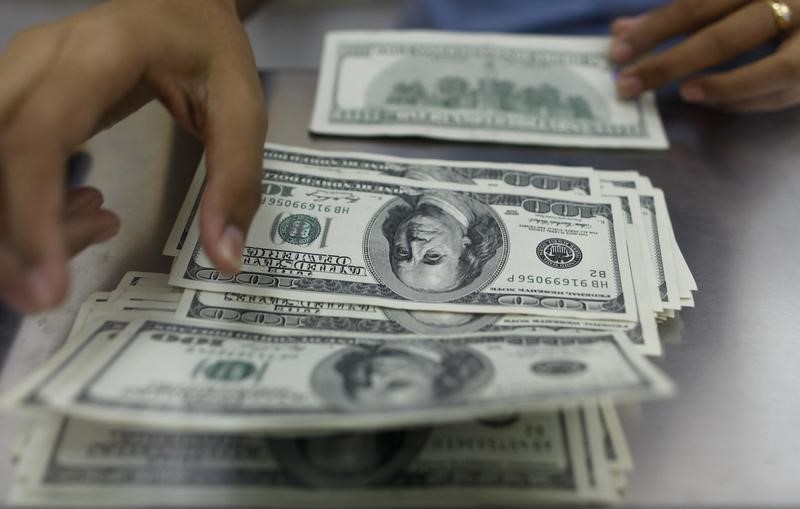Bullish indicating open at $55-$60, IPO prices at $37
Investing.com - The U.S. dollar retreated further Tuesday, falling to multi-year lows on growing expectations of interest rate cuts, while President Donald Trump’s spending bill stoked fiscal worries.
At 04:25 ET (08:25 GMT), the Dollar Index, which tracks the greenback against a basket of six other currencies, dropped 0.2% to 96.275, dropping to its lowest level since February 2022.
Dollar under pressure
The U.S. currency has fallen to multi-year lows, pressured by increasing expectations that the Federal Reserve will cut interest rates in the coming months, optimism of upcoming trade deals, as well as political sparring over a sweeping tax and spending cut bill.
“The dollar continues to grind lower in a move probably now best categorised as an orderly dollar bear trend. After a structurally driven decline of the dollar in April, its losses over the last month or so have become cyclical, as earlier Fed easing becomes priced,” said analysts at ING, in a note.
Expectations of easing from the U.S. central bank are growing, particularly as U.S. President Donald Trump continues to urge the Fed to ease monetary policy, sending Fed Chair Jerome Powell a list of central bank interest rates around the world adorned with handwritten commentary saying the U.S. rate should be between Japan’s 0.5% and Denmark’s 1.75%.
Trump’s constant tirade against the Fed and Powell has fuelled investor worries about the central bank’s independence and its credibility, weighing on the dollar.
Investors are also grappling with uncertainty over the U.S. Senate’s efforts to pass Trump’s tax-cut and spending bill, which faces internal party divisions over its projected $3.3 trillion addition to the national debt.
“Back to the short term, the dollar has come quite far already and this bear trend probably needs feeding with some macro news. That news comes today in the form of the June ISM manufacturing release and the JOLTS data,” ING added.
Euro just off four-year high
In Europe, EUR/USD slipped 0.1% to 1.1781, just below its previously hit four-year high of 1.1808.
The single currency surged 13.8% in the January-June period, its strongest-ever first half performance, LSEG data showed.
Traders are waiting for the latest preliminary inflation data from the eurozone, which is expected to have hit 2% in the year to June, which would be in line with the European Central Bank’s target.
Earlier this month, the ECB cut rates for the eighth time in a year but indicated it would likely pause at its next meeting, citing uncertainty linked to trade tensions with the United States.
Manufacturing purchasing managers indexes data for France, Germany, and eurozone for June are also due for release later in the session, and investors will also study comments from central bank chiefs at the European Central Bank forum in Sintra, Portugal.
GBP/USD gained 0.3% to 1.3764, not far from the three-and-a-half-year high it touched last week.
British house prices fell by 0.8% in June, a sharper fall than forecast and the biggest monthly decline in more than two years, data from mortgage lender Nationwide showed on Tuesday.
“Sterling could also face some political risk as Prime Minister Keir Starmer faces a backbench revolt over welfare reforms. The government has already been forced to make about £4bn of concessions to get the bill through – although its passage is not guaranteed. Any failure to get the bill through could hit sterling and gilts on the view that further concessions will have to be made at a time when there is no fiscal headroom,” ING added.
Japanese yen helped by safe-haven demand
In Asia, USD/JPY traded 0.7% lower to 143.06, with the Japanese currency benefitting from safe-haven demand after President Trump lashed out against Tokyo for alleged unwillingness to buy American-grown rice, while also hinting at ending trade talks with Tokyo.
Japanese officials signaled on Tuesday that they were still pushing for a tariff agreement with the U.S., but would not compromise the country’s agricultural industry for a deal.
USD/CNY slipped marginally lower to 7.1624, close to its strongest level since November following some upbeat purchasing managers index data this week.
Caixin PMI data on Tuesday showed China’s manufacturing sector rose back into expansion territory in June, as local manufacturers benefited from Washington and Beijing agreeing to temporarily slash their respective trade tariffs.
